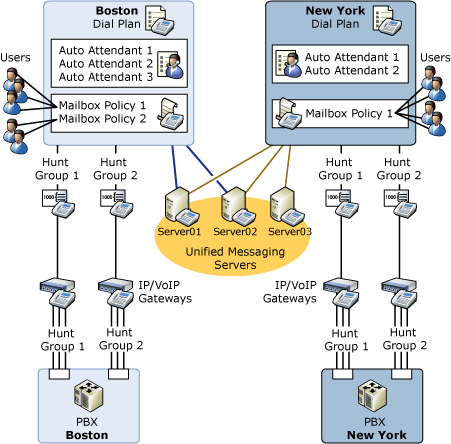Applies to: Exchange Server 2007 SP3, Exchange Server
2007 SP2, Exchange Server 2007 SP1, Exchange Server 2007
Topic Last Modified: 2007-08-29
Active Directory objects are required for the deployment and operation of Microsoft Exchange Server 2007 Unified Messaging (UM). The Active Directory UM objects connect the telephony infrastructure and the Exchange Server 2007 Unified Messaging Active Directory environment.
 UM Active Directory Objects
UM Active Directory Objects
The UM Active Directory objects enable the integration of Exchange Server 2007 Unified Messaging into the Active Directory directory service and the existing telephony infrastructure. Active Directory acts as a container for all the UM objects that are created and their configuration settings. Each UM object within Exchange Server 2007 is necessary to support Unified Messaging in an Active Directory environment. Some UM Active Directory objects are created to logically represent a telephony hardware device whereas others are created to represent a telephony dial plan for an organization or to support a specific feature of Exchange Server 2007 Unified Messaging. The following figure illustrates the relationships between the Unified Messaging objects that are found in Active Directory.

There exists a tightly integrated and interconnected relationship between the UM Active Directory objects and the features that are available in Exchange Server 2007 Unified Messaging. In order to successfully plan and deploy Exchange Server 2007 Unified Messaging in your organization you must fully understand this logical relationship between each of the UM objects.
For more information about the UM Active Directory objects, see:
- Understanding Unified
Messaging Dial Plans
- Understanding Unified
Messaging Mailbox Policies
- Understanding Unified
Messaging IP Gateways
- Understanding Unified
Messaging Hunt Groups
- Understanding Unified
Messaging Auto Attendants
- Understanding Unified
Messaging Servers
- Understanding Unified
Messaging Users
For More Information
- For more information about how to manage Unified Messaging
Active Directory objects, see Managing Unified
Messaging Objects.
- For more information about Exchange Server 2007
Unified Messaging, see Unified
Messaging.

